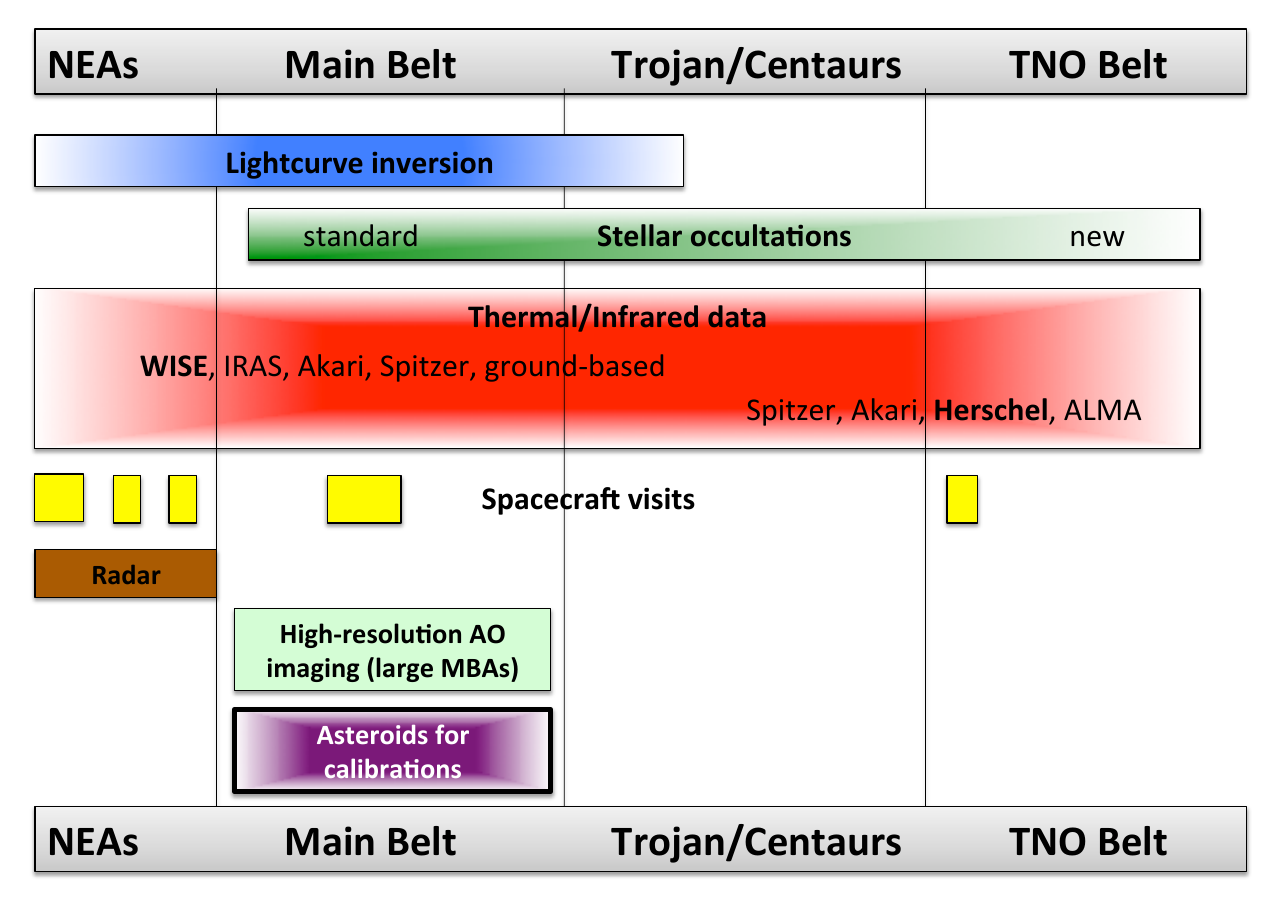Targets
For our benchmark study on minor bodies we selected important targets which were already visited by spacecraft
(or will be visited soon), which have a wealth of data from different observing techniques available
(or are candidates for being observed with new techniques), which are or will be useful in the calibration
context, or which will allow us to address and solve specific scientific questions. These are the small
objects in our Solar System that can be studied the best because of the wealth of data that are available
or that can be obtained.


Near-Earth Asteroids (NEA)
- List of NEAs:
- (433) Eros (NEAR-Shoemaker mission)
- (25143) Itokawa (Hayabusa mission)
- (162173) Ryugu (Hayabusa-2 mission)
- 2015 TB145 (Halloween asteroid)
- Available data:
- Shape, size, spin (NEAR, Hayabusa)
- Thermal data: Spitzer-IRS/-IRAC/-MIPS; WISE/NEOWISE; Herschel-PACS; AKARI; ground-based N-/Q-band
- Ground-based (and space) lightcurves, spectra, auxiliary data
- Radar data (partially available)
- Open points:
- Reconstruction of shape from lightcurves
- Key targets for size, shape and spin reconstruction (and its accuracy)
- Study of surface roughness and thermal inertia effects on disk-integrated observations
- Settling of the degeneracy problem between surface roughness and thermal inertia
- Test and validation of non-convex shape models
- Characterisation of Hayabusa-2 mission target Ryugu before the encounter
- Support for the planning of the close-distance operations for Hayabusa-2 mission
- Support for the scientific interpretation of the Ryugu in-situ measurements
Main-Belt Asteroids (MBA)
- List of MBAs:
- (1) Ceres, (4) Vesta, (21) Lutetia
- Calibration sample: large main-belt asteroids useful for far-IR/Submm/mm calibration (10-20 MBAs)
- Gaia sample: large main-belt asteroids where a mass determination will be possible using Gaia data (up to 50 MBAs)
- list of slowly rotating MBAs
- Available data:
- In-situ information from DAWN & Rosetta
- Wide range of thermal data, including high-quality Herschel measurements, data from Planck, ALMA, APEX, Spitzer, Akari, SOFIA, IRAM, ISO, IRAS, MSX
- Partially HST images, partially Kepler K2 lightcurves, SuperWASP data
- Ground-based lightcurves, spectra, auxiliary data
- Occultation measurements
- AO imaging data
- Open points:
- To establish highly accurate and validated model solutions for thermal flux predictions for calibration purposes
- To develop inversion techniques to determine shape, size, and spin properties from combined visual and infrared measurements
- Settle spin ambiguities by using additional high quality lightcurves, occultation timings and thermal measurements
- Exploit the potential of non-convex methods
- Aim for high accuracy object volumes in support for Gaia
- Study on subsurface emission at submm/mm
More distant objects
- Target list:
- Available data:
- Thermal data from IRAS, ISO, Akari, Spitzer, WISE/NEOWISE, Herschel, ground-based mid-IR
- Ground-based lightcurves, spectra
- Occultation measurements
- Partially HST imaging, partially Kepler K2 lightcurves
- Open points:
- Shape and spin-axis reconstruction from lightcurves, occultations, and thermal measurements
- Development of methods to reconstruct 3D information for remote objects
- Completion of auxiliary data from the ground (lightcurves, absolute photometry, additional occultations)
- Testing sub-surface emission effects to validate radiometric methods for future ALMA observations
